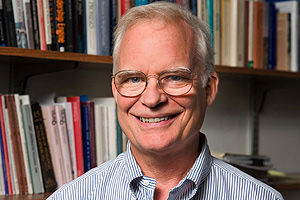|
||
      |
Talking Points
NAME:
Stephen W. Raudenbush

HOMETOWN:
Minneapolis
TITLES:
Lewis-Sebring distinguished service professor,
Department of Sociology and the College; chair, Committee on Education;
coconvener, Urban Education Initiative.
HARVARD DEGREES:
AB’68, social
studies; EdM’80, administration, planning, and social policy; EdD’84,
policy analysis and evaluation research.
PREVIOUS FACULTY POSTS:
University
of Michigan (1998–2005), Michigan State (1984–97), Harvard
(visiting professor, 1991–92).
AREA OF EXPERTISE:
My
interest is in the social organization of schooling and the impact of
social settings, such as schools and neighborhoods, on learning. Specifically,
I’m interested
in how we study those processes—what statistical methods we use.
IN LAYMAN’S TERMS, PLEASE?
In education
the data we collect have two fundamental features. First, children are
learning over time. So a fundamental question is how
we study the growth of children’s knowledge and
skill as they proceed through the grades. Second, learning
occurs in social settings—in interactions with parents, in classrooms,
and in schools. People often refer to this as a “nested
data structure” because children are nested within
classrooms and the classrooms are nested within schools.
Conventional statistical methods have shortcomings in terms of representing both the dynamic, longitudinal nature of children’s growth and the nested structure of the social settings. The work I’ve done over the years has been to develop, test, and refine statistical methods that more realistically represent these two processes—growth with-in social settings.
EDUCATION BY COMMITTEE:
The Committee on Education’s
main goal is to promote educational scholarship. We have two strategies
for doing that. The first is to promote interdisciplinary exchange. Psychologists
are interested in how kids learn, how you can organize instruction to
facilitate learning. Economists are interested in what human-capital
investments will best increase worker productivity, and in how you create
incentives for good people to get into and stay in teaching. Sociologists
are interested in the interplay between children’s social background,
their neighborhood settings, and their schools. People
in the School of Social Service Administration are interested in what
might be called nonacademic barriers to learning: health problems, mental-health
problems—unmet so--cial-service needs that make it hard for kids
to concentrate on academic work.
Our second strategy is to learn from practice. The University is opening its third charter school in the fall, and it is planning to open up to five total charter schools and create a network of up to 15 existing schools that we work closely with. By attempting to put the very best practice into place for kids primarily on the South Side of Chicago, we think we can learn a lot about how to promote teaching and learning. The committee is developing a research agenda to learn from this experience.
THE URBAN EDUCATION INITIATIVE:
We want to create
the educational equivalent of a teaching hospital. In that model you
have people who do basic research, people who do applied or clinical
research, you train professionals, and you do prevention and community
medicine. Connecting those elements is an actual hospital. It’s
in that hospital that you can do clinical trials. It’s in that
hospital where you put into practice what you’re learning from
research.
In the Urban Education Initiative, the Committee on Education does basic re--search. We have applied research at the Con-sortium for Chicago School Research, which maintains, in collaboration with Chicago Public Schools, probably the best data archive of any urban district in the country—we can follow kids’ achievement from 1987 to the present. We have an undergraduate teacher-preparation program. Analogous to community medicine, we have the School of Social Service Administration, which works in school settings on community outreach.
At the center are the schools we run. It’s in those schools that we train our teachers. It’s in those schools that we test out our ideas from basic and applied research. It’s in those schools that our social-service ideas are tried. No other university has this configuration of basic and applied research, professional preparation, and the actual practice of education.
CHICAGO’S COMMITMENT:
One of the most exciting
things about the Urban Education Initiative, and one that affected my
decision to come here, is the fact that the University is committed to
research on urban schooling over the long haul. That’s very unusual
if you look around the country, and that’s what gives us a lot
of confidence that major discoveries in how to solve these problems will
be made at the University of Chicago.
ON CHICAGO’S EDUCATION LEGACY:
It’s
heartening that a university that had such a distinguished tradition
in education for well over 100 years has such a strong renewed commitment
and such a creative approach. It is a wonderful tradition and one that
we in the committee are deliberately aiming to build on.